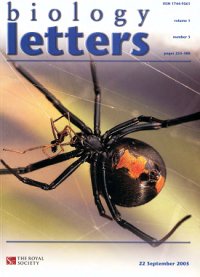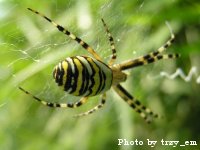
Spiders males are often cannibalized by their mates after sex. Spiders have two penis-like organs, called pedipalps, which usually break during sex meaning male spiders can only have sex twice. I wasn’t going to write about anymore spider sex but I came across a couple articles about the adaptations that can occur since males with no remaining pedipalps males are evolutionary useless. Often females help their mates find purpose by using the male as dinner. Scientists had thought that this was an example of competition between the sexes with the large female taking advantage of the undersized male (like the picture to the left). Sort of a male spiders are from Mars, female spiders are from Cannibal World Centauri 6. But in 1996 M. C. B. Andrade noticed that males of the redback spider actually perform a difficult somersault maneuver just to position their bodies in prime eating position (her video).
This self sacrifice was at odds with the common idea that the females were taking advantage of the unfortunate male. Perhaps there was some sort of evolutionary benefit to make the male want to be eaten. One possibility was that by feeding the female the male is helping his future children. But after Andrade calculated that males were only 1.5% of the mass of a female and only 2.5% the mass of an egg sac and found no increase in egg sac mass after cannibalistic matings, this possibility seemed unlikely. The other possibility was self-sacrifice either increased the male’s proportion of the offspring or prevented other males from mating. Female spiders appear to be the deciding partner for when copulation stops (being 50 times larger will do that). Andrade found that female spiders began eating their mate at the beginning of sex and continued chewing on him throughout. This snacking distraction allowed the sex to last more than twice as long as with non-suicidal males (25 minutes if you’re curious). Since longer sex results in fathering higher proportions of the offspring, this longer sex should result in sacrificial males fathering approximately two times as many children. In addition, virgin females who ate their mate were less likely to accept a second suitor.
These benefits to a male for offering himself up for sacrifice during sex were good but since female spiders have two sperm receiving organs, male spiders that sacrifice themselves on their first mating are potentially leaving other males a crack at half of the offspring. Andrade (with Gu and Stoltz) noticed that many male redback spiders constricted their abdomens prior to mating and thought that this might be an additional adaptation to make their self-sacrifice even more effective. Pictures from the article show the constriction in action:

On the left is an unconstricted male prior to courtship, the middle shows a constricted male with W indicating a decrease in width and L indicating length, and on the right is a wounded male with haemolyph (spider blood) dripping from a wound. Line 1 indicates the usual amount of abdomen eaten after one mating and line 2 indicates the amount after two matings. Arrows in all pictures indicate the location of the constriction and the black scale bar represents 1 mm.
To see what the effect of this constriction was, the researchers teased males with a female until their abdomen constricted. Then they grabbed the males and cut off pieces from their abdomen corresponding to the amount a female would eat after one mating (below the constriction) or after two matings (above the constriction). A control group had pieces amputated without any preparation. Many of the control group and constricted males cut above the constriction died quickly. Constricted males cut below the constriction were able to survive longer. When presented with a female, only about 20% of unconstricted males and males injured above the constriction were able to perform while 73% of the constricted males with one mating’s worth of damage managed to mate. The redback spider appears to have developed a specialized internal tourniquet for sacrificial mating and can even mate again after having half it’s abdomen chewed off. That’s one determined spider lover.
Foellmer and Fairbarn found an even more suicidal spider, Agriope aurantia. They observed that males of this spider die after their second mating even if the female does not attack them. To rule out fatalities caused by pedipalp breakage, the researchers chopped off spiders’ pedipalps themselves but did not observe this spontaneous death. All their spiders’ hearts appear to stop after their second pedipalp is inflated. In fact, they even observed one desperate male returning for a second round of spider loving who mistook the corpse of a mealworm stuck in the web for the female and copulated with the carcass. Even this confused spider died after its bout of misguided sex. Foellmer and Fairbarn suggest that the dead male carcass may form a copulatory plug preventing or delaying other males from mating.
Evolution can bring about some funny adaptations but it’s interesting to see researchers piecing together what the underlying causes are. I guess if you have to go, you might as well go happy (and while increasing your evolutionary fitness) although I wouldn’t mind skipping the being eaten alive by my mate part.

References
M. C. B. Andrade. 1996. Sexual selection for male sacrifice in redback spiders. Science. 271: 70-72
M. C. B. Andrade, L. Gu and J. A. Stoltz. 2005. Novel male trait prolongs survival in suicidal mating. Biology Letters 1: 276-279
M. W. Foellmer and D. J. Fairbarn. 2003. Spontaneous male death during copulation in an orb-weaving spider. Proceeding of the Royal Society of London B. (Suppl.) 270:S183-185
{ 2 }
Related Articles
More Spider Mating Rituals: Butt Drumming :: Dammit Jim! | 27-Jul-2007
Gay Flies and White Genes :: Dammit Jim! | 04-Feb-2008
{ 0 }
Comments